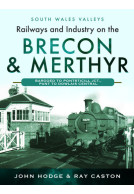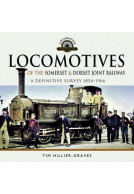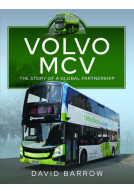South Wales Railways Gallery (Hardback)
Imprint: Pen & Sword Transport
Pages: 144
ISBN: 9781526776013
Published: 4th October 2022
(click here for international delivery rates)
Order within the next 4 hours, 19 minutes to get your order processed the next working day!
Need a currency converter? Check XE.com for live rates
| Other formats available - Buy the Hardback and get the eBook for £1.99! | Price |
|---|---|
| South Wales Railways Gallery ePub (110.7 MB) Add to Basket | £15.59 |
At its peak, the South Wales railway network was one of the most complex in the world. Its primary purpose was to transport Coal from source to point of consumption or export via the various docks. To this was added the other raw materials necessary for making Iron and ultimately Steel, together with the respective products of that industry.
True, there was no glory in this day to day phenomenon and as a consequence, the area has been poorly represented in the annals of the British railway network. Even that paragon of railway publicity the Great Western, found easier plums to pick elsewhere on its system. However, in addition to the GW, the area was a magnet for the London & North Western, the Midland Railway and not to be forgotten, the 15 indigenous companies.
Yet, in terms of traffic, engineering enterprise, operating practices and locomotive types, the area boasted an unequalled variety which this book attempts to reflect. Many of the photographs have not been published before and capture an essence of the variety to be found. The captions contain extensive details to supplement the photographic record enabling a more comprehensive appreciation and understanding of what was involved.
It is difficult to appreciate the railway was once a “Common Carrier” obliged to convey any consignment offered. Even though Coal was predominant other traffic, including the more unusual, are also featured; Although of secondary importance in regard to revenue, Passenger services were carefully dovetailed into the intensive freight operation and matched any other location’s provision.
After the 1923 Grouping, the GW became the major player in South Wales. It absorbed all 15 of the independent companies and further extended its policy of standardisation. Nevertheless, where the smaller companies demonstrated good practices, these were embraced. The L&NW and MR elements became LMSR but still remained far flung tentacles from the parent. All this is recognised here albeit in proportion.
The Gallery aims to provide a flavour of what the railways of South Wales had to offer and enlighten the reader as to its major part in the national network.
"It is a very interesting collection of images collated from a number of sources in addition to the author. The scope of images will also give valuable details for the railway modellers."
Great Eastern Railway Society Newsletter
Those with an interest in Welsh railway history have been well served in recent years by John Hodge’s series of photographic albums on the lines in South and West Wales and the Valleys. These readers are likely to be equally pleased by this album compiled by Stuart Davies, again from Pen & Sword Publishers.
West Somerset Railway Association
This impressive casebound book of 144 pages features historic images from the English border at the Severn Tunnel to the western extremity of Fishguard Harbour, with dozens of locations illustrated in between, and assisted by half a dozen reference maps to aid the reader. Although the book is mainly arranged on an east to west basis, the author has chosen to group together themed images along the way, so that there are sections, for example, on viaducts, signal boxes, locomotive sheds, milk traffic and coal operations, all with detailed and informative captions. Interwoven with the illustrations are a few short narrative sections, including a delightful piece describing the crossing of two trains at Llangynwyd, to the north of Bridgend. The pictures themselves derive from a number of sources, including the Online Transport Archive and Great Western Trust, and include a good number of colour images. Whether colour of black and white, the photos are almost invariably well reproduced, mainly at two to a page, on gloss paper.
With such a rich selection to choose from, it did not prove easy for this reviewer to pick out favourite images. An official image of the extensive sidings at Llanelly Docks in 1921 stands out, as do a couple of magnificent views of the Cardigan branch in full colour. Modellers may well be inspired by the colour image of a Carmarthen to Aberystwyth passenger train near Conwil conveying half a dozen empty milk tanks for Felin Fach creamery. Likewise a lengthy train of ammonia tanks heading for Dowlais is seen at Talybont-on-Usk behind two pannier tanks. Nor will those with a penchant for photos concentrating on locomotives be disappointed.
This is another beautifully presented and worthwhile book to add to published work on the railways of South Wales.
"Highly recommended."
The Railway Correspondence and Travel Society - The Railway Observer, February 2023, Volume 93, Number 1128
Featured in
Welsh Railways Research Circle, No.172 Winter 2022/23
Featured in
The Journal of the friends of the National Railway Museum Winter 2022-23 (No.182)
An excellent photographic survey of South Wales railways during their operational zenith which includes some rare and unusual images.
Books on the Line
Enjoyable and recommended.
Read the review here
Despite my dislike of railway picture books this came across as one of the better pictorial compilations covering South Wales.
Welsh Railways Research Circle Newsletter
The arrangement is broadly South Wales east to west starting at Severn Tunnel Junction (and the tunnel pumping station at Sudbrook) and moving across to Fishguard and the ever delightful Cardigan branch. It also ventures north to Brecon Free Street and Three Cocks Junction.
Pictures are good quality and include some in colour. They are broadly representative of railway life and operations: for example, we have a signalman in his power box, Newport Hillfield tunnel doubling works, wagon labels, Great Western posters, Rhymney, Taff Vale and Barry Railway railmotors and GWR diesel railcars.
Traffic covered include coal of course, but also milk trains, ammonia, fresh fish (some carried in containers for easy trans-shipment), Irish cattle from Fishguard and even an elephant. There is a picture of 4250 with a train of military vehicles at an unstated location, probably Narberth. (I was delighted to see that photograph, as I have a cabside plate from that engine. Bought for £5 10/- in 1964. A lot of money for a teenager with no paper round.)
Nearly all the loco classes to work in South Wales feature including the decidedly chunky Barry. and Port Talbot Railways 0-8-2 tank engines. We are reminded that Ebbw Junction was the second largest shed on the GWR and Aberbeeg had thirty-seven tank engines allocated and no need for a turntable.
So, a better than average photographic compilation. The author was a long serving railway man who has written informative captions. Definitely one to consider buying.
The new book by Stuart Davies, a native of the Ogmore Valley and a life long railwayman, both in South walks and elsewhere, offers a comprehensive portrait of one of the world’s most intensive railway networks, a demonstration of the unequalled railway diversity of South Wales and a reflection of the variety of traffic, engineering enterprise, operating practices and locomotive types to be found in the region.
South Wales Railway and Correspondence and Travel Society
I really enjoyed this book and highly recommend it.
About Stuart Davies
Stuart Davies is a native of the Ogmore Valley and spent much of his formative years observing the operations at Tondu depot and its associated railway environs. This inspired him to pursue a railway career based initially in South Wales, then Carlisle, Bristol, East Anglia and the West Midlands, finally becoming a Senior Operations Executive.

















